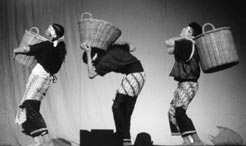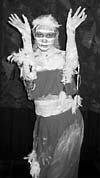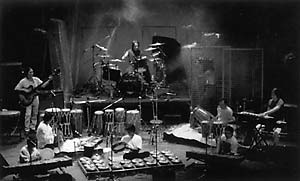Annual Report 2000–2001 home | Mission statement | Chairmans statement | Board membership | Media | Youth and education | Arts and sport | Civil society | Commercial and the professions | Administrative overview | Appendix A: Financial statements | Appendix B: Order-in-Council
ARTS AND SPORT PROGRAM
The Institute aims to cultivate in Indonesia and Australia an appreciation of the quality, diversity and sophistication of the visual and performing arts in the two countries, and to develop a market in Indonesia for Australian visual and performing arts and Australian expertise. It also aims to encourage relations between Australian and Indonesian sports people and organisations.
In 2000–2001, the Institute supported an eclectic range of artistic activities ranging from in-country arts residencies, to collaborative projects and exchanges of tours of Australia and Indonesia by leading contemporary artists. A highlight of the year was the visit to Jakarta under AII auspices of the National Aboriginal and Islander Skills Development Association (NAISDA) Dance College, whose performances were widely acclaimed. The sport program, which was deferred in 1999–2000 after consultation with Indonesian sports officials, remained inactive in 2000–2001.
Arts residencies
Indonesia continues to be a popular destination for Australian artists, reflecting its vibrant traditional and contemporary cultural environment. Since 1993 the Institute has sponsored numerous Australian artists, writers and arts managers undertaking residencies in Indonesia through the Asialink Centre (University of Melbourne) arts residencies program. The residencies provide an opportunity for Australians in the arts field to build enduring linkages with Indonesian counterparts, develop their skills and gain insights into Indonesias artistic institutions. Importantly, the residencies also showcase Australian talent, creativity and innovation to the Indonesia media and wider community. In 2000–2001 the AII supported residencies in Indonesia for visual artist Megan Kirwan-Ward, performing artist Grisha Dolgopolov and arts manager Simon Wellington.

Art residency recipient Grisha Dolgapolov with his production of Demon
The AII was also pleased in 2000–2001 to support the first arts residency in Australia under the Asialink program by an Indonesian, the writer Dorothea Rosa Herliany. Dorothea was hosted by the University of Western Australia and La Trobe University, Melbourne, as well undertaking public speaking engagements in Sydney and Tasmania and writing several pieces for the mass media in Indonesia. During her time at La Trobe University, Dorothea completed her recently published bilingual poetry collection, Kill the Radio. This was a very impressive outcome from her residency.
NAISDA Indigenous dance tour
The Institutes sponsorship of a visit to Indonesia by students from the National Aboriginal Islander Skills Development Association (NAISDA) Dance College was one of the AII success stories in 2000–2001. NAISDAs public engagements in Jakarta included dance performances at the opening of the 2001 Jakarta Arts Festival and before crowds of 700 and 800 respectively at the Indonesia Buddhist Council and the annual dinner of the Australian Alumni Association of Indonesia (IKAMA). Students also conducted a series of workshops with Indonesian counterparts.

A member of the NAISDA Dance College performing at the 2001 Jakarta Arts Festival
The reaction of Indonesian audiences to NAISDAs public performances exceeded all expectations:
It was the first time that a number of Indonesian people had seen, or even understood, that Australia has an Indigenous population with traditional dances. The responses that were received, by students and staff, were overwhelming.
— NAISDA comment.
For many of the NAISDA students, the visit to Indonesia was their first trip abroad and all found the rich Indonesian culture and the opportunity to dance in front of large and enthusiastic audiences an exhilarating experience. Many friendships were forged during the visit and it is expected that both Australian and Indonesian performers will be able to adapt some of each others culture into their own pieces of contemporary choreography.
Krakatau tour
With AII support, the prominent Indonesian jazz fusion group, Krakatau, toured Australia 10–22 October 2000. Krakatau presented a total of eight performances in Noosa, Brisbane, Byron Bay, Canberra and Sydney and complemented these with workshops and informal community meetings. The tour followed an earlier visit to Australia in 1997 and, more recently, performances in France and China.

Indonesian jazz fusion group Krakatau
An estimated 2200 people attended Krakataus performances, while around 330 students participated in the workshops. During the course of the tour, Krakatau members, who are based at the Farai Music School in Jakarta and STSI Bandung, made contact with staff and students at the Noosa Federation of the Arts; Queensland Conservatorium; Canberra School of Music and School of Asian Studies, ANU; the Music Department and Centre for Performance Studies at Sydney University; Languages Department, University of New South Wales; Sydney Conservatorium; Nirimba TAFE, Western Sydney Institute of Technology; and the Australia Indonesia Arts Alliance, Byron Bay. Australian audiences responded very warmly to Krakataus music. Media coverage of the tour was extensive.
The gig at [Brisbane wine bar] Jamesons was partly concert, partly jam session. Brisbane reedmen Nick Aggs, Isaac Hurren and Phil Noy joined the Indonesians, bridging the cultural divide to whip up an impromptu musical storm.
— Courier Mail, 17 October 2000.
In the Shadows of the Buddha
The Institute provided sponsorship for a party of four students, a teacher and an education officer from high schools in Geelong, Victoria to visit Yogyakarta to exhibit at an Indonesian school drawings of the great Buddhist monument, Candi Borobodur, produced by Geelong High School students in 1999. The drawings had been earlier exhibited at the Geelong Regional Art Gallery and, by invitation, at the Indonesian Consulate in Melbourne for Idul Fitri celebrations in January 2000, promoting significant interest in Indonesia for the drawings to be exhibited there.
The Geelong students also travelled to Borobodur with selected Indonesian students to draw en plein air with their Indonesian partners. The results of this collaboratively recorded experience were also hung along with the 1999 drawings at the Yogyakarta exhibition. The opportunity for the Geelong students to experience the magnificent Candi Borobodur monument in the context of gotong royong (cooperation) with Indonesian counterparts left them deeply moved and gained them a deeper respect and understanding of Indonesia and its culture.
Kamus Keramik
In 1999–2000, the Institute assisted the Australian potter Brian Alexander to instruct members of the Indonesian Board for the Research and Implementation of Technology (BPPT) and local ceramic producer, Bali Moon, in the development of new technology and methods to increase the productivity of ceramic artists. As a follow-up to that project, the AII assisted Mr Alexander publish in early 2001 an Indonesian language ceramic dictionary — Kamus Keramik.
It is expected that the dictionary will be published in the second half of 2001. Copies of the book will be distributed free of charge to many universities and professional potteries throughout Indonesia.
Annual Report 2000–2001 home | Mission statement | Chairmans statement | Board membership | Media | Youth and education | Arts and sport | Civil society | Commercial and the professions | Administrative overview | Appendix A: Financial statements | Appendix B: Order-in-Council
